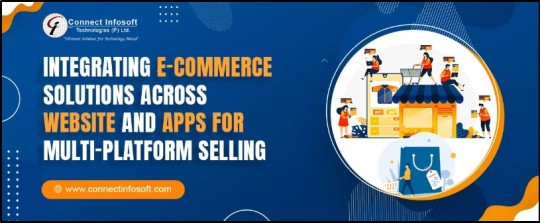#Multichannel ecommerce software
Explore tagged Tumblr posts
Text
Why Inventory Management is Important
Effective inventory management is crucial for businesses of all sizes. It ensures that products are available when needed while minimizing waste and excess costs. Without a proper system in place, companies risk stock shortages, overstocking and financial losses. Here’s why inventory management is essential for business success.
Prevents Overstocking and Stockouts
Balancing supply and demand is key to maintaining a profitable business. Poor inventory management can lead to overstocking, which ties up capital in unsold products and increases storage costs. On the other hand, stockouts result in missed sales and dissatisfied customers. Using inventory management software helps track stock levels in real time, ensuring businesses maintain the right amount of inventory at all times.
Improves Cash Flow and Profitability
Proper inventory control directly impacts a company's cash flow and profitability. Excess inventory can lead to higher holding costs, while inadequate stock levels may force businesses to rush orders at premium prices. By utilizing inventory management software, businesses can optimize their purchasing decisions, reduce waste and ensure capital is used efficiently. This leads to better financial planning and higher profit margins.
Enhances Customer Satisfaction
Customers expect quick and reliable service. If a business frequently runs out of popular items or experiences delays in fulfilling orders, it can lose customer trust. A strong inventory management system helps businesses meet customer demands promptly, improving retention and brand reputation.
Inventory management is essential for maintaining smooth operations, reducing costs and keeping customers satisfied. By leveraging modern technology and best practices, businesses can optimize their inventory processes and drive long-term success.
Simplify your sales and stock with POS and inventory management — visit the website now!
0 notes
Text
Master Your Multichannel Ecommerce Inventory Management!
Are you juggling inventory across multiple ecommerce platforms? Streamline your operations and boost your efficiency with our state-of-the-art Multichannel Ecommerce Inventory Management solution!
✅ Real-time Inventory Updates ✅ Centralized Control Across All Platforms ✅ Minimize Stockouts & Overstocks ✅ Simplify Order Fulfillment ✅ Increase Sales & Customer Satisfaction
Don't let inventory management slow you down. Stay ahead of the competition and keep your business running smoothly.
📞 Contact Us Today! 📧 Email: [email protected] 📱 Phone: (503) 239-1055 🌐 Visit: https://monsooninc.com/
Get started now!

0 notes
Text
Integrating E-Commerce Solutions across Websites and Apps for Multi-Platform Selling

In digital age, e-commerce has become an integral part of the retail industry. With the rapid growth of online shopping, businesses are constantly seeking ways to expand their reach and maximize their sales potential. One effective strategy that has emerged is multi-platform selling, which involves integrating e-commerce solutions across websites and apps to create a seamless shopping experience for customers.
Without a doubt, selling across various platforms is a game changer in the realm of custom eCommerce development, with the potential to propel any organization to new heights. This blog will look at all aspects of multi-platform selling and how it affects the modern eCommerce business scene. Let us get started.
eCommerce Evolution: A New Era of Online Selling
Welcome to the new era of online selling! With the ever-growing popularity of e-commerce, businesses are constantly seeking ways to expand their reach and increase their sales. One such method that has gained significant traction is multi-platform selling, which involves integrating e-commerce solutions across websites and apps.
However, because consumer behaviours and market demands change so quickly, an all-in-one or single eCommerce strategy is insufficient for long-term success. This is where multi-platform selling provides numerous chances for firms looking to increase engagement and diversify their reach.
What Does Multi-Platform Selling Mean?
Multi-platform selling refers to the practice of selling products or services through multiple online channels simultaneously. This approach allows businesses to reach a wider audience and cater to customers' preferences across various platforms, including websites, mobile apps, social media platforms, and marketplaces. By offering a consistent shopping experience across different channels, businesses can enhance customer engagement, increase brand visibility, and boost sales.
Whether you run a little business or a large corporation, if you carefully position your company on these platforms, you will meet all of your customers' expectations by providing a convenient purchasing experience. However, managing sales across several channels is not as simple as it appears; a custom eCommerce development solution is required to optimize the process.
Major Perks of Multi-Platform Selling
There are several significant perks associated with multi-platform selling. Let's take a closer look at some of the major advantages that businesses can enjoy:
1. Expanded Reach: By leveraging multiple platforms, businesses can tap into a larger customer base and target diverse demographics. This broadens their reach and increases the chances of attracting new customers.
2. Enhanced Customer Experience: Multi-platform selling enables businesses to provide a seamless and consistent shopping experience across various channels. Customers can browse products, make purchases, and access support services conveniently, regardless of the platform they prefer.
3. Increased Sales Opportunities: With multiple channels at their disposal, businesses have more opportunities to showcase their products and services and convert leads into sales. Each platform serves as an additional sales channel, increasing the chances of generating revenue.
4. Improved Brand Visibility: Businesses may increase brand awareness and familiarity by maintaining a presence across many media. Consistent branding across channels promotes client trust and loyalty.
5. Better Data Insights: Multi-platform selling allows businesses to gather data from different sources, providing valuable insights into customer behaviour, preferences, and trends. This data can be used to optimize marketing strategies, personalize customer experiences, and drive informed business decisions.
Other key benefits of multi-platform selling include:
Improved conversion rate
Better customer loyalty.
Improved inventory transparency.
Improved customer segmentation.
Mobile commerce trend capitalization
Best Platforms for Multi-Channel eCommerce Business
1. Shopify: Shopify offers a comprehensive e-commerce platform that allows businesses to create and manage online stores. It provides seamless integration with various sales channels, including websites, mobile apps, social media platforms, and marketplaces.
2. Magento: Magento is a highly flexible and scalable e-commerce platform that caters to businesses of all sizes. It supports multi-channel selling by integrating with multiple platforms, enabling businesses to sell across websites, mobile apps, and marketplaces.
3. Etsy: If you want to sell antique, handcrafted, craft supplies, or other one-of-a-kind things online, Etsy is a great place to start. Users may easily access a wide range of product categories on this marketplace, including clothing, jewellery, tools, home, living, kids & babies, and entertainment.
4. Amazon Marketplace: As one of the largest online marketplaces, Amazon provides businesses with a vast customer base and global reach. Selling on Amazon Marketplace can significantly expand the visibility and sales potential of products.
5. eBay: eBay is another popular online marketplace that allows businesses to sell products to a wide range of customers. With its auction-style listings and fixed-price options, eBay offers flexibility for multi-channel selling.
6.Walmart Marketplace: Walmart is a frequently used marketplace that provides excellent prospects for online enterprises. This is a curated e-commerce portal. As a seller, you must meet specified requirements for providing excellent customer service.
7. Facebook Marketplace: This is Facebook's integrated platform that provides fantastic online selling choices to local sellers and small enterprises. This platform is simple to use and helps you promote your goods to a social media-savvy customer audience.
How to Set Up a Successful Multi-Platform Selling Strategy:
1. Identify Target Platforms:
Research and analyse the platforms that align with your target audience and business objectives. Consider factors such as platform popularity, user demographics, and integration capabilities.
2. Seamless Integration:
Select e-commerce platforms that offer robust integration capabilities with various channels. Ensure that your chosen platforms can synchronize product listings, inventory, pricing, and order management across all channels.
3. Consistent Branding:
Maintain consistent branding elements, such as logo, colors, and messaging, across all platforms. This creates a cohesive brand identity and fosters customer recognition and trust.
4. Optimize User Experience:
Provide a user-friendly and intuitive shopping experience on every platform. Optimize website and app performance, ensure mobile responsiveness, and streamline the checkout process to minimize friction and maximize conversions.
5. Data-Driven Decision Making:
Leverage analytics and data insights to monitor and measure the performance of each platform. Identify trends, customer preferences, and areas for improvement, and use this information to refine your multi-platform selling strategy.
6. Customer Support:
Offer consistent and responsive customer support across all platforms. Provide multiple channels for customer inquiries, such as live chat, email, and phone, to ensure a seamless support experience.
7. Cross-promotion:
Cross-promotion is a marketing strategy where two or more parties promote each other's products or services to their respective audiences. It's a mutually beneficial arrangement that can help increase brand exposure, reach new customers, and drive sales.
8. Privacy and Data Security:
- Manage all of your customers' data safely.
- Display all privacy policies to your customers to develop trust.
9. Focus on market trends.
- Keep up with the latest industry developments, platform updates, and client requests.
- Be prepared to change your business approach (if necessary) to stay ahead of the market.
Conclusion:
Multi-platform selling has become a crucial strategy for businesses aiming to thrive in the competitive e-commerce landscape. By integrating e-commerce solutions across websites and apps, businesses can expand their reach, enhance the customer experience, and boost sales. With the availability of various platforms, businesses can choose the ones that align with their target audience and business goals. By implementing a well-planned multi-platform selling strategy, businesses can establish a strong presence across multiple channels, drive customer engagement, increase brand visibility, and ultimately achieve success in the evolving world of e-commerce.
#Multi-Vendor E-Commerce Market Place Software#Best Multi-Channel Listing Software Solutions For Ecommerce Sellers#ECommerce Management Solution#ECommerce Product Management#Best ECommerce Software#Multi-Channel Selling Software#Shipping Software#Multi-Channel eCommerce Inventory Management Software#Product Listing Software#Multichannel Marketplace Software#Connect Infosoft#E-commerce website development#E-commerce website optimization#Mobile commerce optimization#Mobile commerce solutions#Multi-channel sales management
1 note
·
View note
Text
In today's fast-paced e-commerce landscape, businesses are increasingly turning to multichannel order management software to streamline their operations. This powerful tool is designed to help companies efficiently manage orders across various sales channels, including websites, marketplaces, and brick-and-mortar stores.
#multichannel order management#business#ecommerce#order management software#features of multichannel order management
0 notes
Text
Streamlining Success: The Role of Multichannel Ecommerce Solutions and Integrated Logistics Management
In the dynamic landscape of modern business, the integration of cutting-edge technology is imperative for success. This blog explores the significance of multichannel ecommerce solutions, the efficiency brought by integrated supply chain planning, and the role of rental inventory store management software in optimizing logistics operations.

1. Multichannel Ecommerce Solutions: Navigating the Digital Marketplace
Expanding Your Reach:
Multichannel ecommerce solutions empower businesses to expand their reach across various online platforms. From e-commerce websites to social media marketplaces, the ability to connect with customers on multiple channels enhances visibility and increases the potential for sales.
Unified Management:
Managing diverse sales channels can be challenging, but with multichannel solutions, businesses can achieve unified management. Centralized control over inventory, orders, and customer data ensures a seamless and synchronized operation, reducing the risk of errors and delays.
2. Integrated Supply Chain Planning: A Pillar of Efficiency

End-to-End Visibility:
Integrated supply chain planning offers end-to-end visibility into the entire supply chain process. From procurement to distribution, having a comprehensive view enables businesses to make informed decisions, optimize workflows, and respond swiftly to market changes.
Efficient Resource Utilization:
By integrating supply chain planning, businesses can efficiently allocate resources. This includes inventory management, production scheduling, and transportation planning. The result is a leaner and more cost-effective supply chain, minimizing waste and maximizing productivity.
3. Rental Inventory Store Management Software: Precision in Logistics Operations
Optimized Inventory Control:
For businesses involved in rentals, inventory control is paramount. Rental inventory store management software ensures precision in tracking, managing, and replenishing inventory. This leads to better stock levels, reduced holding costs, and an improved overall customer experience.
Real-time Analytics:
Harnessing the power of real-time analytics, rental inventory management software provides insights into demand patterns, helping businesses make data-driven decisions. Predictive analytics can anticipate customer needs, enabling businesses to stay ahead of the curve.
Conclusion: Elevating Logistics Through Integration
In conclusion, the synergy between multichannel ecommerce solutions, integrated supply chain planning, and rental inventory store management software is a recipe for success in today's competitive market. Businesses that embrace these technologies gain a competitive edge by streamlining operations, enhancing customer experiences, and maximizing overall efficiency. As the logistics landscape continues to evolve, investing in integrated solutions becomes not just a choice but a strategic imperative for sustained growth and success. Explore the possibilities that technology integration offers, and position your business for a future where efficiency and precision in logistics operations are the keys to sustainable success.
FOR ORIGINAL POST :- https://froodl.com/The-Role-of-Multichannel-Ecommerce-Solutions-and-Integrated-Logistics-Management
#Multichannel ecommerce solutions#Integrated supply chain planning#Rental inventory store management software
0 notes
Text
youtube
Multi-Channel Market Place Application For E-Commerce Store By Connect Infosoft Tech Pvt. Ltd.
Multi-vendor Marketplace Website Service – A comprehensive solution designed to help you create and manage a thriving online marketplace and integrated with eBay | Bonanza | Google | Newegg | Walmart | Amazon | Yahoo and many more.
Connect InfoSoft provides an eCommerce store with the top-ranking, multi-channel marketplace application. We strive to provide the best service possible for our customers, offering 24/7 customer support and technical assistance to help you get the most out of our platform. We are dedicated to ensuring that our clients have the best experience possible and that their businesses grow to their fullest potential.
For more details:
☎️ +1 323-522-5635 ✉️ [email protected] 🌐 www.connectinfosoft.com
💬 𝗙𝗼𝗹𝗹𝗼𝘄 Instagram ➜ https://www.instagram.com/connectinfosoftpvtltd/ Facebook ➜ https://www.facebook.com/connectinfosofttechnologies LinkedIn ➜ https://www.linkedin.com/in/connectinfosofttechpvtlimited/ Twitter ➜ http://twitter.com/connectinfo_12 YouTube ➜ https://www.youtube.com/@ConnectInfosoftTechnologies Pinterest ➜ https://www.pinterest.com/connectinfosoft/
#ConnectInfosoft#LookingForMultiVendorAppDevelopmentCompany#WebDevelopmentCompany#WebDesigningCompany#MobileApplicationDevelopment#Ecommerce#Software#MultiVendorApp#MultiChannelListingSoftwareSolutions#EcommerceSellers#EcommerceAppDevelopmentService#ManagementSolution#ECommerceProductManagement#BestECommerceSoftware#MultiChannelSellingSoftware#SellOnMultipleSitesFast#FreeShippingSoftware#SellingProducts#eCommerceShop#MultiChannel#eCommerceInventoryManagementSoftware#ProductListingStore#FreeMultiVendorSoftwareForECommerce#MultichannelMarketplaceFreeSoftware#MultiVendorAppDevelopmentCompany#SaaSApplicationDevelopment#SaaSApplicationDevelopmentService#SaaSApplicationDevelopmentCompany#SaaSApplications#SaaSApplicationDevelopmentTeam
1 note
·
View note
Text
Why to Use Direct Mail Automation Software?
In a digital-first world where email inboxes are overcrowded and online ads are skipped, direct mail still offers unmatched engagement and brand recall. But manual mailing is inefficient and outdated. This is where Direct Mail Automation Software steps in—blending the tactile power of physical mail with the efficiency of digital automation.

This article dives deep into the reasons to use direct mail automation software, its core benefits, and how it revolutionizes marketing and operational workflows.
What is Direct Mail Automation Software?
Direct mail automation software allows businesses to send personalized, trackable mail pieces automatically based on predefined triggers or events. These tools eliminate manual mailing processes and integrate seamlessly with CRMs, eCommerce platforms, and marketing software.
Top Reasons to Use Direct Mail Automation Software
1. Time and Cost Efficiency
Automating mail campaigns reduces manual labor, printing errors, and postage costs. It also shortens the mailing cycle from weeks to days, enabling faster campaign execution.
2. Personalization at Scale
With built-in variable data printing (VDP), the software can personalize names, messages, and visuals based on recipient data—driving better engagement and conversions.
3. Trigger-Based Campaigns
Direct mail software integrates with CRM tools to automate mail dispatch based on behaviors like:
Cart abandonment
Subscription renewals
Birthday greetings
Customer churn
4. Multichannel Campaign Integration
Today’s customers interact with multiple touchpoints. Automated direct mail fits perfectly into multichannel workflows—reinforcing digital messages with physical communication.
5. Real-Time Tracking and Analytics
Direct mail automation platforms provide status updates, delivery tracking, and campaign metrics. Marketers gain clear insights into response rates, ROI, and conversion.
6. A/B Testing Capabilities
Just like email campaigns, direct mail can be tested and optimized. Marketers can try different creatives, offers, and formats to determine what works best.
7. High Engagement Rates
Direct mail boasts higher open and response rates compared to email. Automation software helps marketers capitalize on this while maintaining scale and efficiency.
Industries Benefiting from Direct Mail Automation
Retail: Personalized promotions and loyalty program mailers
Real Estate: Property listings, open house invites, market reports
Healthcare: Patient engagement, appointment reminders, wellness programs
Education: Application follow-ups, event invites, alumni campaigns
Finance: Transactional mail, compliance communication, account alerts
Key Benefits for Marketing Teams
Increased Campaign Speed
Reduced Operational Complexity
Better ROI Attribution
Improved Customer Retention
Higher Lifetime Value (LTV)
Top Direct Mail Automation Tools
Lob
Inkit
PostGrid
Postalytics
Quadient Inspire
These platforms offer template builders, CRM integrations, analytics dashboards, and compliance-ready environments.
Use Cases
Onboarding letters for new customers
Re-engagement campaigns for lapsed users
Thank-you cards after purchase
Promotions for upcoming events
Referral reward notifications
Compliance and Security
Reliable automation platforms offer encryption, secure print facilities, and compliance with regulations like:
HIPAA
GDPR
SOC 2
PCI-DSS
Conclusion
Direct mail automation software is the secret weapon for businesses seeking efficiency, personalization, and measurable ROI in their physical outreach. By automating tedious processes and integrating offline channels into digital workflows, it redefines what’s possible with direct mail.
Whether you're a startup or enterprise, it's time to modernize your print communication strategy with automation that performs.
youtube
SITES WE SUPPORT
Automated Mailing APIs – Wix
0 notes
Text
How Much Does Direct Mail API Cost?

Direct mail APIs have transformed traditional mailing processes by enabling seamless automation, personalization, and integration with existing digital systems. As more businesses explore this innovative approach to customer communication, one key question arises: How much does a Direct Mail API cost? In this comprehensive guide, we break down the cost factors, pricing models, and variables that influence the overall expense of integrating and using a Direct Mail API.
1. What is a Direct Mail API?
A Direct Mail API (Application Programming Interface) is a software tool that allows businesses to send physical mail—such as letters, postcards, and brochures—programmatically through their applications or platforms. It automates processes like address verification, printing, and postage without manual effort.
Key Features:
Automated mail dispatch
Address verification and formatting
Personalization at scale
Integration with CRMs, eCommerce platforms, and ERPs
Real-time tracking and delivery analytics
2. Why Businesses Invest in Direct Mail APIs
Before discussing costs, it's essential to understand why companies use Direct Mail APIs:
Efficiency: Reduces manual work by automating entire workflows.
Accuracy: Integrates with address validation tools to reduce undeliverable mail.
Personalization: Offers variable data printing for custom content.
Scalability: Suitable for small businesses to large enterprises.
Multichannel Strategy: Complements digital channels for better engagement.
3. Types of Costs Associated with Direct Mail APIs
There are multiple cost components involved. Below are the most common:
a. API Subscription or Usage Fees
Some platforms charge a monthly or annual subscription, while others offer pay-as-you-go pricing based on API calls.
Subscription Example: $49–$299/month depending on features and volume.
Pay-per-call: $0.01–$0.10 per API request, typically for address validation or job creation.
b. Printing Costs
Direct mail providers charge based on the material, format, color, and number of printed items. Item TypeEstimated Cost per UnitPostcard (4x6)$0.35 – $0.75Letter (1-page, black & white)$0.50 – $1.00Brochure (tri-fold, color)$0.80 – $1.50
c. Postage Fees
Shipping or postage costs vary based on mail class (First-Class, Standard), speed, destination (domestic or international), and size.
First-Class Postcard: ~$0.51
First-Class Letter: ~$0.68–$0.75
International Mail: Starts around $1.50+
d. Address Validation Fees
Many APIs include real-time address validation, which may be priced separately.
$0.005 – $0.02 per address
Bulk pricing available for high-volume senders
e. Setup and Integration Costs
Some providers offer free onboarding, while others may charge for white-glove integration.
DIY setup: Free or minimal cost
Custom integration: $500 – $5,000 depending on complexity
4. Direct Mail API Pricing Models Compared
Let’s compare pricing structures of leading Direct Mail API providers: ProviderSetup FeeMonthly FeePer Mail CostAddress ValidationTrackingLobFreePay-as-you-go$0.73+ per letterIncludedYesPostGridFreeStarts at $49/month$0.60+$0.01/addressYesClick2MailFreePay-as-you-go$0.60+External integration neededPartialInkitCustomCustomCustomIncludedYes
5. How Volume Affects Costs
One of the biggest factors affecting Direct Mail API cost is volume. Bulk mailing offers reduced rates per piece.
Under 500 mailings/month: Higher per-piece cost (~$1.00)
1,000–5,000 mailings/month: Lowered rates (~$0.65–$0.80)
Over 10,000/month: Negotiable enterprise pricing (~$0.50+)
6. Additional Cost Considerations
a. Custom Templates and Design Services
Some platforms offer in-house design assistance.
One-time fee: $100 – $1,000
Template library access: Included with most subscriptions
b. Compliance and Security
HIPAA or GDPR-compliant mailing services often come at a premium.
Compliance fee (if applicable): $0.05 – $0.15 per mail piece
c. International Delivery
Expect increased costs for printing and postage when sending internationally.
7. Free vs. Paid Direct Mail APIs
Free APIs:
Limited access to features
Capped usage or branding included
Useful for testing or low volume
Paid APIs:
Full access to advanced features
More control over branding, tracking, and workflows
Necessary for scaling direct mail campaigns
8. How to Estimate Your Monthly Spend
Let’s walk through an example.
Scenario: You send 1,000 postcards monthly using a Direct Mail API.
Postcard Printing: 1,000 x $0.45 = $450
Postage: 1,000 x $0.51 = $510
Address validation: 1,000 x $0.01 = $10
Monthly API Fee: $49
Total: $1,019/month
9. Tips for Reducing Direct Mail API Costs
Use Presorted Mailing Discounts: USPS and Canada Post offer reduced rates.
Validate Addresses Before Sending: Reduces return mail.
Choose Standard Sizes: Custom shapes and sizes increase costs.
Print in Bulk: Reduces per-unit costs significantly.
Negotiate Enterprise Plans: Most providers offer volume discounts.
10. FAQs About Direct Mail API Costs
Q1: Are there hidden costs in Direct Mail APIs? Some providers may charge extra for tracking, template customization, or compliance features. Always review the SLA and pricing page.
Q2: Can I try Direct Mail APIs for free? Yes. Many providers offer free credits or trial API keys to test their services.
Q3: How does the API handle returns or undeliverable mail? Returned mail may incur an additional handling fee or simply be reported in analytics. Make sure your provider offers return tracking.
Conclusion
Understanding the cost of Direct Mail APIs is crucial for budgeting, ROI tracking, and long-term planning. While costs vary based on volume, complexity, and provider, businesses can optimize their expenses by choosing the right pricing model and leveraging automation effectively. Whether you're a startup launching your first campaign or an enterprise scaling customer outreach, a clear cost analysis ensures you're getting the most from your direct mail investment.
youtube
SITES WE SUPPORT
Healthcare Direct Mail – Wix
0 notes
Text
Benefits of Using Direct Mail Automation
In an age dominated by digital channels, direct mail might seem outdated. However, modern technology has given it a powerful upgrade—automation. Direct mail automation combines traditional print marketing with software-driven efficiencies, helping businesses send personalized, timely, and effective campaigns with minimal effort. This article explores the key benefits of using direct mail automation in 2025 and how it transforms customer engagement.

1. Enhanced Personalization at Scale
One of the most significant benefits of direct mail automation is the ability to personalize campaigns at scale. Using CRM integrations and marketing automation tools, businesses can:
Insert customer names and relevant data into each mailer.
Customize messages based on behavior, preferences, or location.
Match offers with customer lifecycle stages.
Why it matters: Personalized direct mail increases response rates by up to 135%, making your campaigns more effective and memorable.
2. Increased Efficiency and Time Savings
Traditional direct mail campaigns require manual printing, envelope stuffing, and postage handling. With automation software, all these steps are handled programmatically. Marketers can:
Create workflows that automatically send mail based on triggers (e.g., abandoned cart).
Schedule campaigns without human intervention.
Use templates and pre-set designs to save setup time.
Key takeaway: Automation reduces human errors and saves hours or even days of manual effort.
3. Lower Operational Costs
Though direct mail involves printing and postage, automation tools help reduce overall costs by:
Bulk pricing through API-based platforms.
Eliminating manual labor costs.
Reducing waste through better targeting.
Tip: Integrate with address validation APIs to cut undeliverable mail expenses.
4. Real-Time Analytics and Tracking
Unlike traditional snail mail, automated direct mail platforms offer real-time analytics, including:
Delivery status.
Open rates via QR code or URL tracking.
Response and conversion metrics.
Why this helps: Data-driven insights enable better campaign optimization and ROI analysis.
5. Seamless Multichannel Integration
Modern marketing is all about meeting customers where they are. Direct mail automation can be integrated with:
Email marketing tools (e.g., Mailchimp, Klaviyo).
CRM systems (e.g., Salesforce, HubSpot).
Ecommerce platforms (e.g., Shopify, WooCommerce).
This allows for consistent messaging across all channels.
6. Trigger-Based Campaigns
With automation, you can trigger mailers based on customer behavior:
First-time purchase → Thank You card.
Subscription renewal → Reminder mail.
Inactivity → Win-back offer.
Stat: Triggered direct mail increases engagement by over 50% compared to batch campaigns.
7. Improved Campaign Consistency
Automation ensures that every campaign follows the same structure, branding, and timing. This eliminates human inconsistencies and helps build brand trust.
8. Better Compliance and Data Security
Automated direct mail platforms often include:
GDPR and CCPA compliance tools.
Encrypted data transmission.
Audit trails for mail history.
This is especially beneficial for financial and healthcare industries.
9. Eco-Friendly Options
Many direct mail automation companies offer:
Recyclable or biodegradable materials.
Carbon-neutral delivery.
Digital print-on-demand to reduce waste.
Eco-conscious businesses can align marketing with sustainability goals.
10. Scalable for Businesses of All Sizes
Whether you're a startup or an enterprise, direct mail automation scales easily. Small businesses can start with minimal investment, while large companies can manage thousands of campaigns across multiple regions.
Conclusion
Direct mail automation isn't just a marketing trend—it's a powerful tool that offers personalization, cost-efficiency, scalability, and better customer engagement. Businesses looking to bridge the gap between digital and physical experiences should invest in automation to stay competitive in 2025 and beyond.
youtube
SITES WE SUPPORT
Automated HIPAA Mails – Wix
1 note
·
View note
Text
The Future of Direct Mail: How APIs Are Revolutionizing Offline Marketing

In an era dominated by digital communication, direct mail might seem like an outdated relic. However, the evolution of marketing technology—especially Application Programming Interfaces (APIs)—is breathing new life into offline marketing. Businesses are rediscovering the tangible, personal impact of direct mail, and APIs are making it more targeted, automated, scalable, and trackable than ever before.
This article explores how direct mail APIs are revolutionizing offline marketing and what the future holds for brands that leverage this powerful integration.
What Are Direct Mail APIs?
Direct mail APIs are software interfaces that allow businesses to automate the process of sending physical mail—like postcards, letters, or catalogs—through integration with CRM, eCommerce, and marketing platforms. These APIs connect digital systems with printing and mailing providers, enabling seamless campaign execution.
Core features include:
Customization and personalization at scale
Address verification and standardization
On-demand printing and mailing
Tracking and reporting capabilities
Event-triggered campaign launches
How APIs Are Changing the Direct Mail Landscape
1. Hyper-Personalization with CRM Integration
Direct mail APIs allow you to pull customer data directly from your CRM, enabling you to personalize messages just like you would with email marketing. Imagine sending a handwritten-style thank-you postcard within 24 hours of a purchase—automatically. That’s the power of CRM-API integration.
2. Real-Time Automation
APIs automate mailings based on customer behavior. For example:
Abandoned cart? Send a follow-up postcard.
Subscription renewal upcoming? Mail a reminder with a discount code.
Customer inactivity? Trigger a win-back offer via direct mail.
This real-time response was nearly impossible with traditional offline marketing methods.
3. Data-Driven Campaign Optimization
Thanks to APIs, direct mail campaigns now include:
Delivery tracking
Engagement analytics (via QR codes, pURLs, and call tracking)
A/B testing capabilities
These analytics enable marketers to test and tweak campaigns for better ROI—just like in digital marketing.
4. Scalability Without Complexity
APIs scale from 10 to 100,000+ pieces effortlessly. Whether you're an SMB or enterprise, automation handles data formatting, printing specifications, postage, and mailing logistics.
5. Compliance and Security
Direct mail APIs ensure compliance with GDPR, HIPAA, and other data privacy standards. Leading API providers offer end-to-end encryption, access control, and audit trails.
Benefits of Using Direct Mail APIs
Cost Efficiency: Reduce manual processing, errors, and waste.
Speed: Execute campaigns in minutes instead of days or weeks.
Personalized Experience: Treat offline recipients like online users.
Multichannel Integration: Bridge offline and online for omnichannel campaigns.
Increased Engagement: Physical mail has higher open and response rates compared to email.
Use Cases in Various Industries
eCommerce
Abandoned cart reminders
Order confirmations
Customer retention campaigns
Real Estate
Localized open house invitations
Property listing updates
Financial Services
Statements and policy renewals
Regulatory compliance mailings
Healthcare
Appointment reminders
Preventive health checkup campaigns
Technological Trends Shaping the Future
1. AI-Powered Personalization
Combining APIs with AI enables predictive modeling to send the right message to the right person at the right time.
2. IoT and Direct Mail Integration
Smart devices can now trigger physical mail events. For example, when a refrigerator senses you're low on milk, it could trigger a coupon postcard for a nearby grocery store.
3. Sustainability through Smart Targeting
APIs help minimize waste by ensuring only qualified leads receive physical mail, thus supporting eco-friendly marketing strategies.
Choosing the Right Direct Mail API Provider
Consider the following:
API documentation and ease of integration
Address verification and CASS/NCOA support
Postal carrier support (USPS, Canada Post, etc.)
Security certifications (SOC 2, ISO 27001)
Custom branding and design capabilities
Challenges and Considerations
Initial setup complexity – Though APIs simplify long-term processes, initial integration requires technical know-how.
Data hygiene – The effectiveness of campaigns hinges on accurate and up-to-date customer data.
Design and creative – Physical design remains a key factor in response rates.
Conclusion: A Future-Proof Strategy
Direct mail is not dead—it’s evolving. APIs are the bridge between analog and digital, making offline marketing smarter, faster, and more effective. Businesses that embrace direct mail APIs gain a tangible edge in customer engagement, retention, and ROI. In the coming years, expect to see even deeper integration between direct mail and the rest of the marketing tech stack, paving the way for a new era of programmatic offline marketing.
youtube
SITES WE SUPPORT
Automated Mailing API – Wix
1 note
·
View note
Text
Boost Your Business Efficiency with a Multichannel Order Management System!
Are you struggling to keep track of orders from multiple sales channels? Say goodbye to the chaos and hello to streamlined operations with our state-of-the-art Multichannel Order Management System!

🔹 Seamless Integration: Connect all your sales channels – online stores, marketplaces, and more – into one cohesive system.
🔹 Real-Time Inventory Management: Never oversell or undersell again. Keep your stock levels accurate across all platforms.
🔹 Automated Order Processing: Save time and reduce errors with automated order fulfillment and tracking.
🔹 Enhanced Customer Experience: Provide your customers with timely updates and faster delivery, boosting their satisfaction and loyalty.
🔹 Comprehensive Analytics: Gain insights into your sales performance and make data-driven decisions to grow your business.
Ready to take your business to the next level?
Contact us today to learn more about how our Ecommerce Order Management Solution can revolutionize your operations!
📞 Phone: (503) 239-1055
📧 Email: [email protected]
🌐 Website: https://monsooninc.com/
Don't let the complexities of multichannel selling hold you back. Simplify, automate, and thrive with MOMS!
#marketplaces#OrderManagement#EcommerceSolutions#BusinessGrowth#MultichannelSelling#CustomerSatisfaction#multichannel#onlinemarketplaces#ebay#amazon#ecommerce#management#software
0 notes
Text
ODOO CRM
Unlock Sales Success with Odoo CRM: A Deep Dive into Features, Benefits & Use Cases
In today’s competitive market, success depends not just on how many leads you generate—but how effectively you manage them. That’s where a modern Customer Relationship Management (CRM) system like Odoo CRM becomes a game-changer. It’s not just software—it’s a sales enabler, lead generator, and business optimizer, all rolled into one.
In this article, we provide a comprehensive guide to Odoo CRM, exploring its features, benefits, use cases, integration capabilities, real-life success stories, and more.
What is Odoo CRM?
Odoo CRM is an open-source, fully integrated CRM solution that helps businesses manage their sales pipeline, customer relationships, and sales performance—all in one intuitive interface. Part of the broader Odoo ERP suite, it seamlessly connects with other modules like Sales, Marketing, Accounting, Inventory, and Helpdesk.
Whether you're a startup or an enterprise, Odoo CRM is built to scale with your business.
Powerful Features of Odoo CRM
Here’s a deeper look at the tools that make Odoo CRM stand out:
1. Sales Pipeline Visualization
Customize your Kanban view to match your sales process.
Drag-and-drop leads through stages like New, Qualified, Proposal Sent, Won, and Lost.
Color-coded tags help prioritize and categorize leads.
2. Automated Activities & Smart Scheduling
Automatically schedule follow-ups after key milestones.
Set up recurring meetings, calls, or reminders.
Integrates with Google Calendar, Outlook, and mobile devices.
3. Multichannel Communication
Sync with your email, VoIP, and SMS tools.
Use pre-written templates for quicker responses.
All conversations are logged and linked to the lead’s profile.
4. Lead Scoring & Assignment Rules
Score leads based on criteria like job title, location, industry, or behavior.
Automatically assign hot leads to top-performing reps.
Route leads by geography, language, or campaign source.
5. Custom Reports and Real-Time Dashboards
Monitor KPIs such as:
Lead conversion rate
Sales cycle length
Deal size by rep or team
Export reports or automate them on a schedule.
6. Mobile-First Experience
Native mobile apps for iOS and Android.
Access lead data, update opportunities, and get notifications while on the move.
Key Benefits of Using Odoo CRM
Here’s what businesses love about Odoo CRM:
All-in-One Platform: No more switching tools—everything from marketing to invoicing is connected.
100% Customizable: Add custom fields, change workflows, or build new apps using Odoo Studio.
User-Friendly Interface: Clean, modern UI that reduces the learning curve.
Affordable & Scalable: Pay for what you use. Start small and scale up when needed.
Global Community & Support: Backed by a massive open-source community and certified partners worldwide.
Real-World Integrations
Odoo CRM integrates seamlessly with:
Odoo Email Marketing: Launch personalized drip campaigns.
Odoo Website: Capture leads through embedded web forms.
Odoo eCommerce: Track leads generated through online purchases.
Third-party apps: Zapier, WhatsApp, Slack, Twilio, and more.
Use Cases by Industry
Real Estate
Track buyers, sellers, and properties.
Automate appointment reminders and open house follow-ups.
B2B SaaS
Monitor monthly recurring revenue (MRR).
Run email nurture sequences to onboard free trial users.
Retail & Wholesale
Connect CRM to inventory for real-time stock updates.
Assign sales reps based on customer region or purchase history.
Professional Services
Manage client onboarding, invoicing, and renewals from one dashboard.
Customer Testimonials
“We switched from Salesforce to Odoo CRM and cut our CRM costs by 70%. It's simpler to use and integrates better with our accounting and invoicing tools.” — Lucia Martinez, COO, GreenTech Innovations
“Our sales reps love the mobile app. It helps them update leads right after meetings, which has improved our data accuracy dramatically.” — James Andrews, Head of Sales, UrbanEdge Realty
🛠 How to Get Started
Step 1: Sign up for a free trial at odoo.com
Step 2: Choose the CRM module and activate related apps like Sales, Email Marketing, and Invoicing.
Step 3: Customize your sales stages, import leads, and set up team permissions.
Step 4: Train your team (Odoo offers built-in tutorials and documentation).
Step 5: Start selling smarter and tracking every opportunity!
Final Thoughts: Is Odoo CRM Right for You?
If you're looking for a cost-effective, powerful, and fully integrated CRM, Odoo is hard to beat. Whether you’re a solopreneur or managing a global sales team, Odoo CRM offers the flexibility, functionality, and affordability that modern businesses demand.
Unlike many CRMs that force you into their mold, Odoo lets you define your own sales journey—and powers it every step of the way.
Ready to Transform Your Sales Strategy?
Explore Odoo CRM for free
Talk to our Odoo-certified experts Get a tailored demo for your business
VISIT:https://banibro.com/odoo-crm/
Email: [email protected]
0 notes
Text
Mastering Growth: The Significance of Multichannel E-Commerce and Implementation Strategies
In the dynamic landscape of e-commerce, the adoption of a multichannel strategy has become a linchpin for success. This blog sheds light on "Why Multichannel E-Commerce Is Important" and provides insights into "How to Implement It," encompassing key elements such as Multichannel Ecommerce Solutions.

Unraveling the Importance of Multichannel E-Commerce
1. Expanding Market Reach
Multichannel e-commerce opens the door to expanded market reach. By diversifying sales channels beyond a standalone website, businesses can tap into various platforms, reaching a broader audience and increasing brand visibility.
2. Enhancing Customer Experience
A multichannel approach contributes to an enhanced customer experience. It allows consumers to engage with a brand through their preferred channels, whether it's an online marketplace, social media platform, or traditional storefront. This flexibility fosters a seamless and personalized customer journey.
3. Optimizing Sales Potential
Multichannel e-commerce maximizes sales potential by meeting customers where they are. Businesses can leverage the strengths of different platforms, tailoring strategies to suit each channel's unique audience and optimizing the overall sales funnel.
Implementing Multichannel E-Commerce: A Strategic Approach

1. Investing in Multichannel Ecommerce Solutions
Choosing the right multichannel ecommerce solutions is a critical first step. These solutions should seamlessly integrate with various sales channels, offering centralized inventory management, order processing, and customer data, ensuring consistency across platforms.
2. Integrated Ecommerce Order Fulfillment Software
Integrated ecommerce order fulfillment software is paramount for a successful multichannel strategy. This software streamlines order processing, inventory management, and shipping across all channels, providing real-time updates and reducing the risk of errors.
3. WMS for Ecommerce: The Backbone of Efficiency
A Warehouse Management System (WMS) tailored WMS for ecommerce is the backbone of operational efficiency. It ensures accurate inventory levels, efficient order picking, and timely order fulfillment, aligning seamlessly with the demands of a multichannel e-commerce environment.
Conclusion: Paving the Way for E-Commerce Mastery
In conclusion, the importance of multichannel e-commerce cannot be overstated in the contemporary digital marketplace. As businesses strive for growth, adopting a multichannel strategy becomes not only a competitive advantage but a necessity.
By investing in robust multichannel ecommerce solutions, integrated ecommerce order fulfillment software, and a purpose-built WMS for ecommerce, businesses pave the way for e-commerce mastery. The journey towards a seamless, customer-centric, and operationally efficient multichannel presence is a journey towards sustained growth and success in the ever-evolving e-commerce landscape.
For Original Post :- https://www.articlewood.com/mastering-growth-the-significance-of-multichannel-e-commerce-and-implementation-strategies/
0 notes
Text
Find the Perfect POS System for Your Business
No matter the size or type of your business — café, boutique, or supermarket — the right POS system can be a game-changer for your efficiency and growth.
But with so many options out there, it can be confusing to figure out which one fits your needs. This guide will walk you through the types of POS system available and help you make a smarter decision.

💡 What is a POS System?
A POS (Point of Sale) system is the technology businesses use to complete sales transactions. It includes both hardware (like a POS machine) and POS software that manage sales, inventory, and customer data.
Modern POS billing software does much more than just process payments — it's a complete POS solution that streamlines your operations.
🧾 Different Types of POS System
Let’s explore the most common types of POS system used across industries:
1. Mobile POS (mPOS)
Perfect for: Pop-up shops, food trucks, small retail stores.
Works on smartphones or tablets.
Cost-effective and easy to set up.
Ideal POS system for small business owners on the move.
2. Cloud-Based POS System
Perfect for: Retail chains, restaurants, multi-location businesses.
Stores data online for easy access.
Real-time inventory and sales updates.
Allows remote management via the internet.
3. Terminal POS
Perfect for: Medium to large retail stores and restaurants.
Traditional setup with a monitor, cash drawer, barcode scanner, and receipt printer.
Comes with robust POS billing and inventory features.
Reliable and suitable for handling high-volume transactions.
4. Self-Service Kiosk POS
Perfect for: Quick-service restaurants, cinemas, ticket counters.
Allows customers to place and pay for orders themselves.
Reduces wait times and enhances customer experience.
Common in fast-paced environments.
5. Multichannel POS System
Perfect for: Businesses selling both online and offline.
Syncs data from your physical store and eCommerce platforms.
Centralized inventory and customer data.
Great for building a seamless shopping experience.
Why Understanding the Types of POS System Matters
Knowing the types of POS system helps you:
Choose the right point of sale system for your business size and needs.
Improve transaction speed and customer satisfaction.
Simplify inventory and staff management.
Ensure accurate POS billing and sales tracking.
Quick Checklist Before Choosing a POS
Before you decide, ask yourself:
Do I need a POS solution that supports mobile sales?
Is cloud access important for my team?
How complex is my inventory management?
Am I planning to sell on multiple platforms?
🚀 Final Thoughts
Selecting the right POS system is crucial for running a smooth, efficient business. From mobile POS to advanced point of sale systems, each type offers unique advantages.
Match your business needs with the right POS software to unlock better performance and happier customers.
Ready to upgrade your POS? Explore the best solutions that fit your business size and goals — and take your sales game to the next level! 💼
#TypesOfPOSSystems#POSSystemForSmallBusiness#RetailPOSSolutions#RestaurantPOSSystems#CloudBasedPOS#MobilePOSSystem#POSHardwareAndSoftware#BestPOSForBusiness#TabletPOSSystem#PointOfSaleTechnology
0 notes
Text
Why Your Marketing Stack Needs Direct Mail Automation Software in 2025

In the rapidly evolving digital marketing landscape of 2025, marketers are constantly seeking ways to improve customer engagement, enhance campaign performance, and streamline workflows. While digital channels such as email, social media, and search advertising remain crucial, a surprising and highly effective player is gaining renewed attention—direct mail. More specifically, direct mail automation software is proving to be a game-changer for businesses aiming to build omnichannel strategies that stand out.
This article explores why your marketing stack needs direct mail automation software in 2025, the key benefits it offers, and how to implement it effectively for maximum ROI.
What is Direct Mail Automation Software?
Direct mail automation software integrates with your CRM, e-commerce, or marketing platforms to trigger and manage print mail campaigns as easily as sending an email. These platforms enable marketers to send personalized postcards, letters, catalogs, and more through automated workflows—eliminating the manual steps involved in traditional direct mail campaigns.
Why Direct Mail Still Matters in 2025
Even in a digital-first world, direct mail boasts open rates of over 90%, compared to the declining engagement of email (often below 20%). In an age of inbox overload and digital fatigue, physical mail offers a tactile, attention-grabbing alternative that stands out in the marketing mix.
Key Statistics:
Direct mail has a response rate of 4.4%, compared to 0.12% for email (Data & Marketing Association).
73% of American consumers say they prefer being contacted by brands via direct mail because they can read it whenever they want (Epsilon).
42% of direct mail recipients either read or scan the mail they receive.
Benefits of Direct Mail Automation Software in Your Marketing Stack
1. Seamless CRM Integration
Direct mail automation software connects with CRMs like Salesforce, HubSpot, and Zoho, allowing marketers to:
Trigger mail based on user behavior.
Segment audiences using advanced criteria.
Track performance using analytics dashboards.
2. Hyper-Personalization at Scale
Unlike traditional bulk printing, automated platforms support:
Variable data printing.
Dynamic templates.
Personalized QR codes and URLs.
This increases engagement by delivering relevant content tailored to each recipient.
3. Enhanced Multichannel Campaigns
Combining direct mail with digital strategies like email, SMS, and retargeting ensures brand consistency and improves ROI. A coordinated multichannel approach leads to:
3x higher engagement rates.
40% more conversions.
4. Real-Time Triggered Campaigns
Using behavioral triggers (cart abandonment, inactivity, subscription anniversaries), marketers can automatically send relevant mail pieces at the right time.
Example: A cart abandonment postcard sent within 24 hours can increase return visits by 60%.
5. Better ROI Tracking
Modern platforms provide tools to track:
Delivery status.
Conversion metrics via UTM links and QR codes.
Cost-per-acquisition comparisons.
This level of transparency was once unavailable in traditional direct mail.
How Direct Mail Automation Software Works
CRM or Marketing Tool Integration – Connects to your data source.
Audience Segmentation – Filters contacts based on demographics, behavior, or purchase history.
Campaign Creation – Choose templates or design custom mail pieces.
Trigger Setup – Define events (e.g., abandoned cart, birthday) that trigger mailings.
Automated Fulfillment – Printing and mailing are handled by the platform’s backend partners.
Analytics & Optimization – Monitor performance, A/B test creatives, and refine campaigns.
Features to Look for in Direct Mail Automation Platforms
FeatureBenefitCRM & eCommerce IntegrationsTrigger personalized mail automatically.API AccessEnables workflow customization.Variable Data PrintingPersonalize every piece at scale.A/B TestingTest formats, headlines, and offers.Campaign TrackingMonitor delivery and conversion metrics.Print Network ManagementGlobal mailing support and cost efficiency.
Top Use Cases in 2025
1. E-Commerce Re-Engagement
Retailers use direct mail to recover abandoned carts or inactive users. Personalized coupons and product recommendations drive significant returns.
2. SaaS Customer Retention
Subscription-based platforms send milestone postcards and physical thank-you notes to improve lifetime value (LTV).
3. B2B Lead Nurturing
Printed brochures or proposal summaries create a tangible touchpoint for decision-makers in complex sales cycles.
4. Event Marketing
Send personalized invitations, reminders, and thank-you cards to increase attendance and post-event engagement.
Popular Direct Mail Automation Tools in 2025
Lob – API-based solution for enterprises and developers.
PostPilot – E-commerce-focused platform with Klaviyo integration.
Poplar – Visual workflow builder and robust segmentation tools.
Sendoso / Reachdesk – Combines direct mail with gifting strategies.
Click2Mail – USPS-certified platform with document automation.
youtube
SITES WE SUPPORT
Automated Postal APIs – Wix
0 notes
Text
2025’s Leading Address Validation Software: Features, Reviews & Comparison
Address validation software has become a cornerstone of operational excellence in 2025. From customer onboarding to order fulfillment and direct marketing, it helps businesses avoid costly errors while enriching databases. But with dozens of tools on the market, choosing the right one can be overwhelming.

In this guide, we review and compare the top address validation software of 2025 based on performance, usability, integration, support, and user feedback.
What Is Address Validation Software?
Address validation software ensures that addresses entered into a system exist and are deliverable. It corrects misspellings, formats addresses to postal standards, and, in many cases, appends geolocation data.
Key functions include:
Syntax correction
Postal format standardization
Verification against postal databases
Geocoding and reverse geocoding
Real-time and batch processing
Top Features in 2025’s Leading Address Validation Software
Real-Time Validation
Autocomplete & Suggestion Engines
Global Postal Database Access
CASS, SERP, PAF Compliance
Data Enrichment & Analytics
Multichannel Support (Web, Mobile, API)
Security (SOC-2, GDPR, HIPAA compliance)
The Best Address Validation Software of 2025 (With Reviews)
Here are the best tools ranked based on feature set, customer reviews, and overall performance:
1. Loqate
Rating: ★★★★★
Strengths: Global data reach, geocoding, real-time validation, ease of integration
Integrations: Shopify, WooCommerce, Salesforce, BigCommerce
Ideal For: Global retailers and logistics
User Review: “Loqate is our go-to for international orders. Never had a failed shipment since we integrated it.”
2. Smarty
Rating: ★★★★☆
Strengths: Fast API, easy to use, affordable pricing, developer-friendly
Integrations: Native APIs, third-party tools via Zapier
Ideal For: SMBs, developers
User Review: “Smarty is blazing fast and easy to plug in. Our form abandonment dropped by 22%.”
3. Melissa
Rating: ★★★★★
Strengths: Data quality services, enrichment, compliance support
Integrations: HubSpot, Microsoft Dynamics, NetSuite
Ideal For: Data-driven teams, marketing departments
User Review: “Melissa helped us clean a 500k-record database. The difference in deliverability was immediate.”
4. PostGrid
Rating: ★★★★☆
Strengths: Print/mail integration, compliance, fast support
Integrations: CRMs, EHRs, and Zapier workflows
Ideal For: Healthcare, finance, law firms
User Review: “We love the HIPAA compliance and ability to automate physical mailings.”
5. AddressFinder
Rating: ★★★★☆
Strengths: Excellent for Australia & NZ, fast & accurate suggestions
Integrations: Shopify, Magento, WooCommerce
Ideal For: Regional eCommerce platforms
User Review: “A must-have for businesses in Australia. Address accuracy is spot-on.”
6. Experian Address Validation
Rating: ★★★★★
Strengths: Enterprise-grade, high data accuracy, trusted brand
Integrations: Enterprise CRMs, ERPs
Ideal For: Fortune 500 and multinational companies
User Review: “No-brainer for enterprise-level address hygiene. Support is world-class.”
youtube
SITES WE SUPPORT
Verify Postcards Online – Wix
0 notes